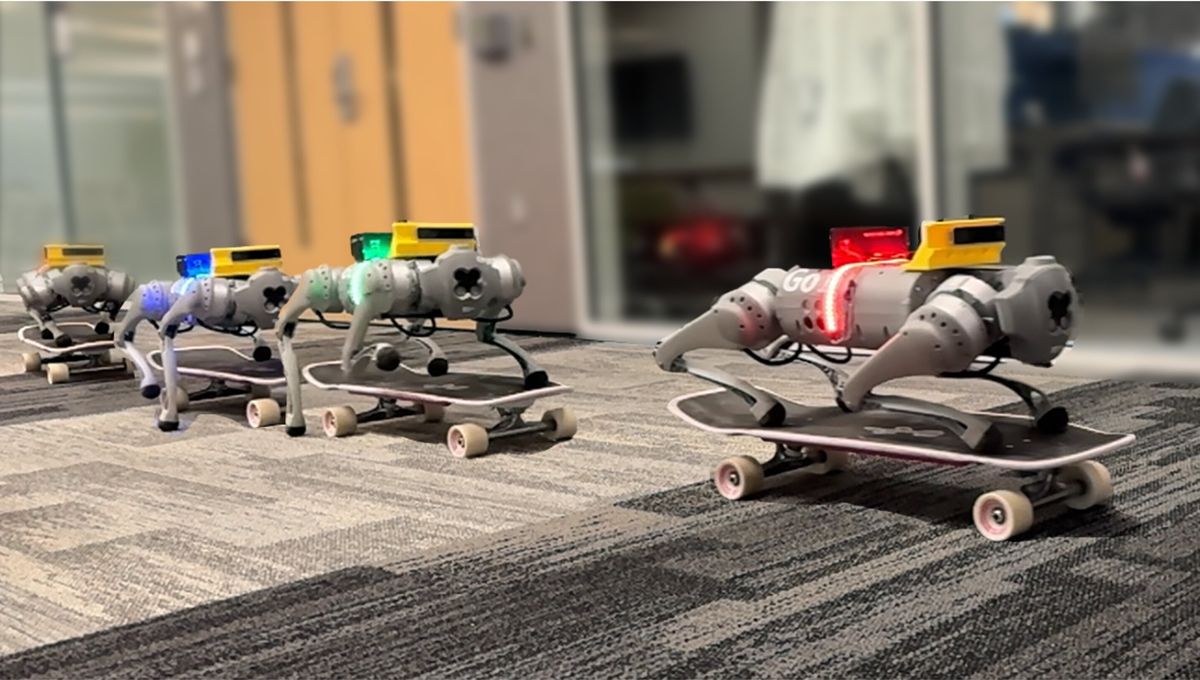
From the Mechanical Turk to Rosey Jetson to Data himself, robots have often been imagined as sophisticated machines, capable of running a household while winning at chess and enjoying a good Sherlock Holmes mystery. But here’s a counterpoint: what if, in real life, we just made them do sick heelflips and ollies instead?
ADVERTISEMENT
It’s not as senseless as it sounds. “Existing quadrupedal locomotion approaches do not consider contact-rich interaction with objectives,” explained Sangli Teng, a PhD student at the University of Michigan’s Computational Autonomy and Robotics Laboratory, aka the CURLY Lab, and coauthor of a new yet-to-be-peer reviewed paper aiming to fill in that gap in the literature. Their solution: an algorithmic framework for training robots with reinforcement-based learning, designed specifically for coping with complex and changeable contact-based tasks.
What kind of tasks, you say? Well… skateboarding. Obviously.
“Our work was aimed at designing a pipeline for such contact-guided tasks that are worth studying, including skateboarding,” Teng told TechXplore this week. “The University of Michigan has a long history of developing hybrid dynamical systems, which inspired us to identify such hybrid effects via data-driven approaches in AI.”
It is, basically, the pinnacle of robotics that they’re aiming for. Legged robots, able to interact with the world with hybrid dynamics – that is, able to switch between smooth movement and jumpy, discrete changes. “For example, when a bouncing ball interacts with the ground, the ball has continuous dynamics in the air and discrete state transitions when colliding with the ground,” Teng explained.
Such dynamics are vital for imitating natural movement, and are widely used in robotics already – but they’re not exactly easy to implement, for a couple of reasons. If you beef up the algorithm’s restrictions, it doesn’t leave enough wiggle room for those switches between behaviors to work properly; if, on the other hand, you try to leave it more open, letting the robot learn for itself when to change up its style, then you’re likely relying on unpredictable and potentially insufficient input. It’s lose-lose.
To counter these problems, Teng and his colleagues developed what they call Discrete-Time Hybrid Automata Learning, or DHAL: “a framework using on-policy Reinforcement Learning to identify and execute mode-switching without trajectory segmentation or event function learning,” the paper explains. Basically, it’s a way to make the robots themselves figure out when and where their behavior should change – “compared to the existing methods, DHAL does not require manual identification of the discrete transition or prior knowledge of the number of the transition states,” Teng said.
ADVERTISEMENT
For example, “in the pushing, gliding and upboarding phase, DHAL will automatically output different labels,” he explained. “Our method can be applied to state estimation of hybrid dynamical systems to find out if such transition occurs. With this transition information, the system can better estimate the states to assist the decision making.”
That doesn’t just mean less work for the human programmers. DHAL results in more smooth, intuitive movement than previous frameworks – the robots not only came up with movements that totally made sense for skateboarding, but they were so proficient that they could mount the boards independently, pull carts along behind themselves, and even successfully navigate a real-world skate park (which sounds all kinds of adorable, if we’re honest).
Now, while nobody’s arguing that teaching tiny robots to skateboard isn’t a noble goal in and of itself, the team has other ambitions for their work. While the robots are still pretty limited in skill – they can’t do anything super complex yet like any rad ollies or Smith grinds or, if we’re honest, just getting up off the board and walking away – in future, they and their programs might have myriad applications.
“We now plan to apply this framework to other scenarios, such as dexterous manipulation (i.e., the manipulation of objects with multiple fingers or arms),” Teng told TechXpress. “DHAL is expected to predict the contact more accurately, thus allowing planning and control algorithms to make better decisions.”
ADVERTISEMENT
The paper, which has not yet been peer-reviewed, can be read on the ArXiv.
Source Link: Skateboarding Robots? Skateboarding Robots!